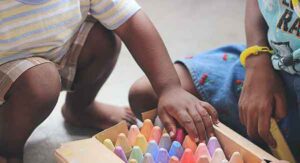On a regular basis, I meet parents who are wondering how to develop their child’s artistic talent and help the child become an artist. There are, however, some general steps that a parent can take to nurture their child’s artistic abilities and develop their skills. Here is some advice I give to parents that ask me “How Can A Child Become An Artist?”
Get some advice from a professional artist or an art teacher to help you with basic ideas to get your child in the right direction. Purchase a variety of art mediums like crayons, coloured pencils, paint, and more, then encourage your child to experiment with them. Arrange age-appropriate art activities for your child like art classes, and workshops on a regular basis. Organise visits to art spaces like galleries and museums. Monitor the progress but examine your intentions to ensure you want what is in your child’s best interest and not an ego boost for yourself.

Giving guidance, exposing them to mediums and activities and making them have loads of practice in their earlier years helps their young minds keep focus before they reach the age to enrol in a higher institution like college or university. It tremendously helps children get a good perspective about what might turn out to eventually be an exceptionally rewarding career.
Speak To Art Teacher Or Professional Artist

An art teacher or professional artist is an invaluable asset to a parent that has a child who is artistically inclined. Many parents I speak with aren’t artists by profession or have friends who are artists. This is a simple problem.
Go to your child’s school and speak with an art teacher or even several art teachers. If you have older children or children in different schools, meet up with their art teachers as well to get different perspectives and build your network. Discuss your challenge of wanting to encourage your child’s artistry and ask for tips or advice. Foster a relationship with these teachers. They will be a lifeline and continually provide you with information when you need it.
Take it a step further. Search for local artists in your area. There are tons of them on social media and I believe visual artists are some of the most approachable people on earth. Make contact and ask if you can take a trip to their art studio and take your child with you to meet up with them.
Do you live in a town with a higher institution? Find out if they have a department or faculty of art. There are amazing human beings in departments and faculty of arts in higher institutions. Their wealth of knowledge is extensive and academically documented. A visit to these places also almost always offers a mini exhibition across the departments.
This was my strategy when I started my art career even though I was an adult. I went to the University of Port Harcourt Nigeria where I live and introduced myself to a then Senior Lecturer in the Department of Painting. He is now a professor and at the time of writing as well as the Head of the Department, Professor Nics Ubogu. I received advice worth more than gold and to this day, I have made lifelong friends including Amanda Okowa and Ashley Stewart who are also lecturers in the department and are unarguably my biggest support systems professionally.
Your child may not be of university age but an art professional from a higher institution like a university, polytechnic or college will be a great investment in guiding your child in the right direction because of their invaluable experience.
Expose Your Child To A Variety Of Mediums
Your child’s passion for art and desire to create things can be fostered and encouraged by exposing the child to a variety of artistic mediums. Providing potential child artists with mediums like crayons, coloured pencils, charcoals, artistic pencils, paint (acrylic, watercolour and gouache), clay, and more allows them to experiment and explore different techniques, encouraging their creativity and imagination. It also helps develop their fine motor skills, such as hand-eye coordination and dexterity.
Working with different mediums also enhances problem-solving skills because it requires a child to think creatively and solve problems. Figuring out how to create more colours from primary colours such as red, yellow and blue, creating a 3D effect with clay, and other art-related activities with mediums, enhance a child’s ability to resolve problems and become more resourceful.
As a child learns to master different mediums, they become more confident and feel more accomplished. Working with mediums also helps develop a child’s focus and concentration as pay attention to detail and follow through on a project.
Younger children will need supervision to use some of these mediums so that they do not ingest them. One good thing is that many art mediums sold in stores have recommended age for use on the packaging. If you are in doubt, ask the store attendant or check the manufacturer’s website.
Do not introduce these mediums at the same time so that your child doesn’t become overwhelmed, suffer shiny eye syndrome and maybe even lose interest altogether. Observe them over time to find which ones they enjoy the most and have a natural talent for then provide more of those mediums.
Overall, providing a child artist with various mediums can be a valuable learning experience that encourages creativity, enhances problem-solving skills, and builds confidence.
Arrange Age Appropriate Art activities
It is crucial for a child to receive proper instruction and guidance from experienced artists and this can come in the form of attending art classes or workshops, hiring a private art tutor, or joining a youth art program. These educational opportunities can provide the child with the knowledge and skills they need to improve their technique and develop their own artistic style.
It is important to factor in the age of the child. A child between the ages of 1 to 5 years of age will be motivated differently than a child between the ages of 15 to 17 years of age. Their learning techniques will also be different. A younger kid will have a lesser attention span than an older kid. So as a parent, creative activities for developing artistic talent in younger children should be designed in shorter lengths of time than those of older children.
Just like with any other skill or profession, practice is also an essential component of becoming an artist. The more a child practices their art, the better they will become. Encourage the child to set aside time regularly to create and hone their craft. Depending on the school’s responsibilities, it could be daily or weekly. Don’t overload them as it could make them lose interest.
These activities could involve working on a series of drawings or paintings or practising a specific technique. Consistency is key. Help them become consistent and monitor their progress over time.
Visit Museums And Art Galleries
In addition to practising their art, it is also important for a child to be exposed to a variety of art forms and styles. This can be done by visiting art museums and galleries, attending art shows and exhibitions, and even watching art-related documentaries and programs. These experiences can provide the child with inspiration and ideas for their own artwork, as well as give them a broader understanding of the art world.
Visiting museums and galleries can be a valuable learning experience for children and offers a range of advantages. It helps expand knowledge by providing an opportunity for children to learn about different cultures, art styles, and historical periods.
Viewing artefacts in museums encourages children to think critically about what they see and consider the meaning behind them. It also enhances their art vocabulary because the discussions they have within art spaces make them learn the new vocabulary they in turn use to express their thoughts and observations.
When their young minds are visually stimulated, their creativity and imagination are boosted. Visits to museums and galleries help kids develop an appreciation for the arts and the role they play in society. In addition to being a fun and educational experience for them.
Be The Parent Who Guides Not The Parent Who Enforces
Your decision to support and develop your child’s artistic career deserves a pat on the back because some parents do not see art as a viable career option. You should however not set impossible expectations and mount unnecessary expectations for our child.
It is important for parents to support their child’s interests and passions, but it is also important to allow children to make their own decisions and follow their own paths in life. While it may be tempting to encourage a child to pursue a particular career or hobby, it is important to respect their autonomy and allow them to make their own choices. Look inwards and do an honest self-examination of your intentions towards your kid. Are your intentions truly for your child’s interest or for yours?
The simple way to know if your intentions are healthy is to ask yourself if you would be okay after all your investments of time, energy and otherwise, your child woke up one day to say they are done with being an artist and want to go in a completely different direction like joining the army. If your answer is yes, then your intentions towards your child are genuine and have nothing to do with boosting your own ego. Children can easily change their minds on short notice and parents must learn how to handle this without becoming overly emotional.
Parents must bear in mind that forcing a child to pursue a career or hobby that they are not interested in can lead to frustration and resentment, and may ultimately hinder their growth and development. It is important to have open and honest communication with your child and to listen to their thoughts and feelings about their interests and goals.
While it is natural for parents to want to guide and support their children, it is important to remember that each child is unique and has their own strengths, interests, and goals. It is important to foster a positive and supportive environment where children can explore and discover their own passions and interests, rather than trying to force them into a particular path.
Conclusion
Becoming an artist is a unique and personal journey that varies for every individual including children. Ultimately, it takes time, dedication, and a willingness to continuously learn and improve. Depending on what makes the person tick, every artist’s journey will be different.
By following these steps and nurturing their passion for art, children can develop their artistic abilities and become successful artists.



